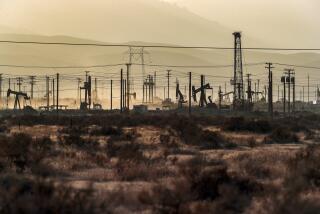U.S. Government Oil Stash Springs a Leak : Energy: Crude stored in salt cavern threatens to pollute Gulf of Mexico. It will be pumped out and sold at a loss.
- Share via
NEW ORLEANS — A plan to stash billions of gallons of crude oil in vast salt caverns as a hedge against another Arab embargo has turned into an expensive headache for the government.
One southern Louisiana cavern--a former salt mine--is leaking. Left alone long enough, it could release a flood of oil and pollute miles of swampy coastline where the Gulf of Mexico’s crab, shrimp and fish breed.
Over the next two years, the Energy Department plans to pump out the 3 billion gallons of oil, paying for the operation by selling 10% of the oil at a $100-million loss.
Meanwhile, engineers are digging refrigerated wells to freeze the water that has been seeping into the salt mine and enlarging the leak.
Everyone agrees that the oil must be pumped out, but environmentalists say it never should have been stored at Weeks Island--one of hundreds of subterranean salt mountains that poke their tips up into the swamps of southern Louisiana, Texas, Mississippi and Alabama.
The amount of oil involved is 300 times the size of the Exxon Valdez disaster in 1989. “That loss was well documented in terms of the loss to wildlife and land,” said Eric Huber of the Sierra Club Legal Defense Fund.
The problem has its roots in the 1973 Arab oil embargo and the long lines at gasoline stations that the embargo created.
The strategic petroleum reserve was created to store up to 31.5 billion gallons of crude oil in case of another crisis. Under the plan, about 25 billion gallons of oil has been stockpiled in six caverns in Texas and Louisiana at a cost of $4.5 billion.
Only the cavern at Weeks Island--two abandoned mine shafts the government bought from Morton Salt Co.--is leaking.
Morton started mining the salt dome near New Iberia around the turn of the century and is still working most of it.
The government became aware of leaks after a 35-foot deep sinkhole was discovered on the Morton property in 1992. After they had studied it for a while, geologists realized that the mining had created tiny cracks in the mountain that let water seep into the salt cavern.
If the seepage continues, the scientists said, the water may force out the oil and pollute the swamplands, Vermilion Bay and neighboring inlets into the gulf.
“That area is a large nursery ground for shrimp, crabs and a lot of the fish species offshore. It is used a tremendous amount by commercial fishermen as well as recreational fishermen,” said Wilma Subra of Subra Co., an environmental consulting firm in New Iberia.
The government says it will take two years to finish the job. Right now, 55 wells are being dug around the sinkhole. Refrigerant circulating through pipes in those 200-foot-deep holes will freeze the ground water, preventing more seepage.
To cover the cost of the cleanup, the Energy Department proposes to sell oil that was bought for about $30 a barrel in the 1970s and ‘80s. Because the price of oil has dropped sharply, they expect to offer it for $15 a barrel. That will raise $105 million, the cost of the cleanup.
Republican Rep. Billy Tauzin tried and failed to stop the proposed sale. He agrees that the oil has to be moved but believes the government should wait until the price goes up before selling it.
It may be a hard sell. Weeks Island is full of hard-to-refine, high-sulfur “sour” crude.
During the Persian Gulf War, the government offered for sale nearly 34 million barrels of crude from the reserve--one-third sweet, two-thirds sour. Oil companies snapped up the sweet; the government got acceptable bids for less than 3 million barrels of the sour.
Subra has been critical of the plan from the start, because it is so hard to monitor changes hundreds of feet inside the salt dome.
“They estimate that the sinkhole started to develop in 1970,” she said. “That’s before [the Energy Department] even took over. So they actually created the storage facility while the crack was developing that’s causing the sinkhole.”
More to Read
Sign up for Essential California
The most important California stories and recommendations in your inbox every morning.
You may occasionally receive promotional content from the Los Angeles Times.













